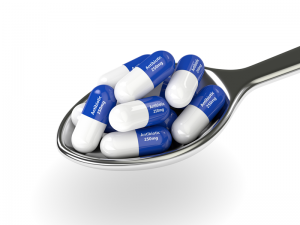By Deborah Jeanne Sergeant
 The Centers for Disease Control and Prevention states that 25 percent of antibiotic prescriptions aren’t necessary. But it’s more than simply wasting medication for a case where it cannot help. Over-prescribing antibiotics contributes to a major health issue: antibiotic resistance.
The Centers for Disease Control and Prevention states that 25 percent of antibiotic prescriptions aren’t necessary. But it’s more than simply wasting medication for a case where it cannot help. Over-prescribing antibiotics contributes to a major health issue: antibiotic resistance.
“It’s a never-ending battle between bacteria and fungi,” said physician Phillip Gioia, with Children’s Health Specialists in Auburn. “When we use antibiotics, it creates resistance. Part of it is humans are using more and more of them. Part of it is medical. They’re not working like they’re used to.”
He added that countries where antibiotics are available without a prescription experience many more bacterial infections that resist antibiotics.
“If every time you have a sniffle you get an antibiotic, it’s not a good thing,” Gioia said. “There’s a greater chance you’ll have resistance.”
Overuse can cause both individual resistance, when a particular person discovers antibiotics don’t work as well as they used to, and universal resistance, when bacteria mutate to the point where no antibiotics can treat them, regardless of a person’s history of taking antibiotics. Dubbed “super bugs,” these more aggressive bacteria are tough to kill.
As one example, Mark McSwain, pediatrician and internal medicine doctor with Auburn Internal Medicine & Pediatrics, said that in Auburn, about 30 percent of ear infection cases are resistant to the antibiotics the office regularly uses.
“Antibiotics are being overused, used to treat viral symptoms and people aren’t completing the course of the antibiotic when it is needed,” McSwain said. “You don’t kill that infection but expose it to the antibiotic.”
Some people like to save antibiotics they don’t use in case they’re sick later and want an antibiotic, but McSwain said that often leads to people taking an antibiotic when they don’t need it or taking the wrong antibiotic. This practice also contributes to super bugs.
Because antibiotics kill both good bacteria and bad, patients are more susceptible to yeast infections, diarrhea and stomach upset. The natural flora of the gut and, in women, vagina, are negatively affected. Their use can disrupt the gut flora for months.
“The antibiotics attack not only the bad bacteria but will attack the good bacterial we carry in our bodies that protect us from serious illness,” said physician Jana Shaw, associate professor of pediatrics at Upstate Golisano Children’s Hospital and epidemiologist at pediatric infectious diseases at SUNY Upstate Medical University.
“They can cause severe colitis and fevers that can be extremely difficult to treat.”
So why are doctors prescribing antibiotics to patients who don’t need them? Undue patient pressure on physicians represents one reason, according to Shaw.
Pediatricians often face upset parents who want something they think will help their sick, crying children.
“Parents often demand antibiotics for their children because they feel their children are sick enough and antibiotics are warranted,” Shaw said. “They often don’t understand the difference between viral and bacterial illnesses. They believe the antibiotics will make their child feel better.”
To appease parents, some providers routinely prescribe antibiotics for illnesses such as ear infections; however, an increasing number of providers are becoming more stringent in when they’ll prescribe the medication.
The requirement of electronic medical records may also influence prescribing. They tend to focus on patient satisfaction, as does media feedback.
Shaw said that reducing unnecessary prescription relies upon education. Antibiotics cannot help viral infections. Anti-viral drugs can help for rare, serious viral illnesses for people prone to complications, but are not prescribed for routine cases.
For those, Gioia suggests watchful waiting. Vital signs such as breathing problems obviously indicate an emergency, but otherwise, parents should monitor temperature to ensure it’s not higher than 100.
Goioa recommended using salt water nose drops and humidifiers to help clear congestion from the nose of small babies.
“They’re nose breathers, so congestion in the nose can put them in the hospital,” he said.
For symptoms like sore throat, try cool foods like applesauce, soup, clear liquids and juice.
Shaw recommends warm liquids like tea with honey to treat colds. Children under 1 year old should not have honey.
“Give them chicken soup and have them rest,” Shaw said. “There’s really not much more you can do in terms of targeting the virus. You have to help your body get through it.

